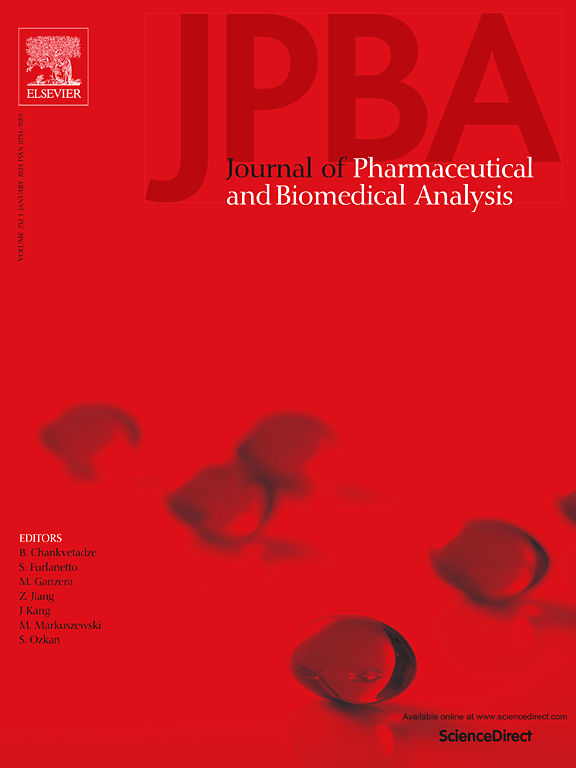Inter-laboratory study for extraction testing of medical devices
IF 3.1
3区 医学
Q2 CHEMISTRY, ANALYTICAL
Journal of pharmaceutical and biomedical analysis
Pub Date : 2024-10-09
DOI:10.1016/j.jpba.2024.116496
引用次数: 0
Abstract
Biocompatibility evaluation of medical devices often relies on chemical testing according to ISO 10993–18 as a critical component for consideration. However, the precision associated with these non–targeted chemical characterization assessments has not been well established. Therefore, we have conducted a study to characterize intra–laboratory (repeatability) and inter–laboratory (reproducibility) variability associated with chemical testing of extractables from polymeric materials. To accomplish this, this study focused on two polymers, each with nine chemicals that were intentionally compounded into the materials. Eight different laboratories performed extraction testing in two solvents and subsequently characterized the extracts using gas chromatography and liquid chromatography methods. Analysis of the resulting data revealed the central 90 % range for the repeatability and reproducibility relative standard deviations are (0.09, 0.22) and (0.30, 0.85), respectively, for the participating laboratory methods. This finding implies that if the same sample was tested by two different laboratories using the same extraction conditions, there is 95 % confidence for 95 % of systems that the test results could exhibit differences up to 240 %. While the study was not designed to evaluate the relative impact of specific underlying factors that may contribute to variability in quantitation, the data obtained suggest the variability associated with analytical method alone is a substantial contribution to the overall variability. The relatively large reproducibility limits we observed may have significant implications where variability in extraction measurements can impact aspects of biocompatibility risk evaluation, such as exposure dose estimation and chemical equivalence assessments.
医疗器械萃取测试的实验室间研究
医疗器械的生物相容性评估通常依赖于 ISO 10993-18 标准的化学测试,这是评估的关键要素。然而,这些非目标化学表征评估的相关精度尚未得到很好的确定。因此,我们开展了一项研究,以确定与聚合物材料中可萃取物的化学测试相关的实验室内(重复性)和实验室间(再现性)变异性。为了实现这一目标,本研究重点关注两种聚合物,每种聚合物中都有 9 种有意混入材料中的化学物质。八家不同的实验室在两种溶剂中进行了萃取测试,随后使用气相色谱法和液相色谱法对萃取物进行了表征。对所得数据的分析表明,参与实验室方法的重复性和再现性相对标准偏差的中心 90 % 范围分别为(0.09,0.22)和(0.30,0.85)。这一结果表明,如果由两个不同的实验室使用相同的提取条件对同一样品进行检测,95% 的系统有 95% 的把握认为检测结果可能会出现高达 240% 的差异。虽然这项研究并不是为了评估可能导致定量变异的特定基本因素的相对影响,但所获得的数据表明,仅与分析方法有关的变异性就对总体变异性有很大影响。我们观察到的相对较大的重现性限制可能会产生重大影响,因为萃取测量的变异性可能会影响生物相容性风险评估的各个方面,如暴露剂量估算和化学等效性评估。
本文章由计算机程序翻译,如有差异,请以英文原文为准。
求助全文
约1分钟内获得全文
求助全文
来源期刊
CiteScore
6.70
自引率
5.90%
发文量
588
审稿时长
37 days
期刊介绍:
This journal is an international medium directed towards the needs of academic, clinical, government and industrial analysis by publishing original research reports and critical reviews on pharmaceutical and biomedical analysis. It covers the interdisciplinary aspects of analysis in the pharmaceutical, biomedical and clinical sciences, including developments in analytical methodology, instrumentation, computation and interpretation. Submissions on novel applications focusing on drug purity and stability studies, pharmacokinetics, therapeutic monitoring, metabolic profiling; drug-related aspects of analytical biochemistry and forensic toxicology; quality assurance in the pharmaceutical industry are also welcome.
Studies from areas of well established and poorly selective methods, such as UV-VIS spectrophotometry (including derivative and multi-wavelength measurements), basic electroanalytical (potentiometric, polarographic and voltammetric) methods, fluorimetry, flow-injection analysis, etc. are accepted for publication in exceptional cases only, if a unique and substantial advantage over presently known systems is demonstrated. The same applies to the assay of simple drug formulations by any kind of methods and the determination of drugs in biological samples based merely on spiked samples. Drug purity/stability studies should contain information on the structure elucidation of the impurities/degradants.

 求助内容:
求助内容: 应助结果提醒方式:
应助结果提醒方式:


